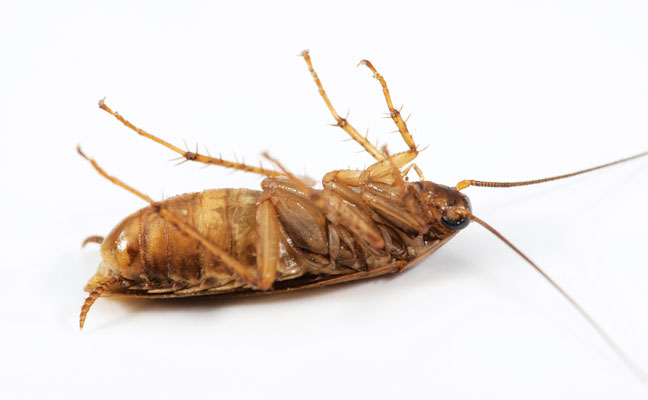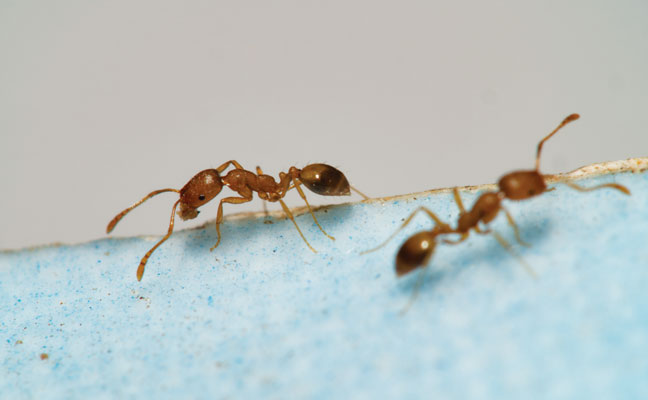
Dr. Bill Robinson (Photo: Aaron Spicer)
Professional pest management has a collection of beliefs, myths and misconceptions that many have subscribed to for years. The basis of many of these myths is “they are logical to assume.” Some people say things because they seem plausible. Others believe and pass on these myths, and the misguided pest control practices tied to them perpetuate.
Pest control is chock full of myths: There is one rat for every person on Earth (untrue). Cockroach nymphs can’t eat old bait (untrue). Many baits lose 50 percent of their water content within 48 hours, so they become less effective (untrue: Without as much water, the baits become more potent).
Myths often are believed without question. Some are even part of our industry’s training background — in part because they have a “wow” factor, and simply can sound logical. Many myths are harmless, but some are not. Some pest control myths hinder our expectations, applications, product stewardship and results. It’s time to bust these myths perpetuating misguided common practices and impeding many pest management professionals’ (PMPs’) effectiveness in the field.
Sticky traps
▶ The location or direction cockroaches are facing on a sticky trap does not indicate the directions of the harborages from where they came.
Cockroaches can forage in any direction after leaving harborages, not just in one direction. Males and large nymphs travel the most, and the farthest, and enter sticky traps randomly. However, a trap with a captured female cockroach, especially one carrying an egg case, might indicate a nearby harborage.
▶ An empty sticky trap, or one with only a few captured cockroaches, does not indicate control or a small infestation.
German cockroaches (Blattella germanica) in particular move along edges, rarely in open spaces. Traps placed along baseboards or cabinet edges are the most effective in intercepting cockroaches. Traps placed 1 inch (or more) away from baseboards will capture significantly fewer cockroaches. Poor sticky trap placements can give PMPs “false readings” of low infestation levels, limiting treatment strategies and control effectiveness.

The more you know: Cockroach control can be tricky, so make sure you’re not misinformed. PHOTO: © GENE WHITE
Caulking for cockroaches
▶ Caulking cracks and crevices along kitchen sinks and cabinets does not necessarily increase German cockroach control.
The assumption is that filling visible cracks and crevices would deny cockroaches entry into harborages and increase control. Research, however, has shown this isn’t true. It’s the 3/16-inch crevices inside cabinets that are the primary harborages, and these are too small to locate and too numerous to eliminate. Caulking for cockroaches usually stems from classic “seems logical” reasoning, but there are no data to support this myth. The practice can waste time and material.
Baiting for cockroaches
▶ Gel baits exposed to insecticide sprays or dusts are not repellent to German cockroaches.
After the introduction of cockroach baits, the first “logical assumption” was bait placements would be contaminated by spray droplets and repel cockroaches. Research, however, has shown this is not the case. Cockroaches readily consume bait that has been exposed to sprays and dusts. Progressive PMPs understand this and have developed programs that integrate spray and dust applications along with baits.
▶ Gel baits that develop hardened coverings after application are not avoided by cockroaches.
The high water content of baits makes them attractive to cockroaches. But up to 50 percent or more of many baits’ water content is lost within 48 hours of placement. Water loss creates thin, hardened surfaces on the baits. However, research showed these coverings did not deter German cockroaches, even small nymphs, from eating the bait. In fact, the water loss increases the concentration of baits’ active ingredients, which makes them more potent.
▶ Gel baits that are several days, a week or even months old, are not avoided by cockroaches.
The teeth on the mandibles of cockroaches are sharp and strong. Research has proven adult and nymph cockroaches are capable of eating baits two days, two weeks, and even 10 months after applications. Separate tests showed small nymphs consumed old bait with hard coverings. The persistent myth that cockroaches don’t eat old bait simply is not true.
▶ Bait stations handled by technicians who smoke cigarettes are not repellent to cockroaches.
This nicotine repellency myth emerged soon after the introduction of small plastic bait stations for cockroach control. Research showed there was no basis for this assumption. High concentrations of nicotine solutions applied to bait stations deterred neither adult nor nymph cockroaches from entering the stations or eating bait.

Sanitation standards: While it’s certainly easier to treat a clean space, a dirty space doesn’t have to be a dealbreaker. Photo: Thomas Northcut/DigitalVision/Getty Images
Rotating insecticides
▶ Excess insecticide spraying will not deliver faster, longer-lasting control.
The insecticide rotation concept emerged around 1990, without supporting research. This idea arrived fully formed with a six-month rotation schedule for cockroach infestations, and a list of eligible insecticides. The original concept was untested on field populations of German cockroaches, and there are no data showing insecticide rotation has any influence on resistance. Even at the time, the author of the insecticide rotation plan for cockroaches cautioned the theory was untested and may not work.
To avoid the marketing hype and busywork of changing products, toxicologists recommend the best strategy is to use a product for as long as it’s effective and then change. This is the “don’t fix the unbroken radio” concept as it pertains to pest control.
Think before applying
▶ To reiterate, excess insecticide spraying will not deliver faster, longer-lasting control.
Wetting surfaces will not make pests more dead, and higher concentration rates will not make pests more dead.
▶ Excess dusting will not guarantee control, either.
Dusts can work very well; just don’t overapply them. If you can see the dust, it’s probably too thick.
If you can see the insecticidal dust, the pests can see it, too, and probably will try to avoid it.
▶ Pushing dry foam into pipes will not ensure control of drain flies.
Drain flies (Psychodidae) breed at the top rim of drains and pipes. That’s where you need to treat.
▶ Soaking carpeting will not guarantee flea control.
Most insecticide sprays penetrate just the top one-third of carpeting, so don’t overapply. Overkill does not equal more kills.
Cleaning for control
▶ Thorough cleanings of infested sites will not result in reduction of German cockroach infestations.
The typical cause given for residential infestations is messy kitchens. The typical recommendation is cleaning will prevent or solve the problems. Research, however, shows this common practice may not work.
A cleaning program was tested in urban apartments. It consisted of 10 to 12 hours of intense cleaning to start, then two hours of cleaning per visit, twice a week, for four weeks. After the thorough cleanings, there was no significant reduction in the cockroach infestations. The research showed how difficult it is to remove all potential cockroach food sources in apartments.
We have found cockroach infestations are more about water sources than food scraps: German cockroaches were in New York City apartments in the 1800s. There were enough food scraps and harborages to support them, but serious infestations were few. In 1847, the Croton Reservoir brought indoor plumbing to Manhattan tenements and apartments. Sinks and tubs now had spigots and running water. Infestation quickly spread and the German cockroach got a new name: the Croton bug. Food and harborages already were in the apartments. All that was missing was water.
It’s all about the water.
Mistaken identity
▶ After you spray, German cockroaches only get fatter!
Some version of this is a common refrain about German cockroach control from residential and commercial customers. But it’s not a complaint. It’s an observation worth studying and understanding.

Formidable Foes: Pharoah ants (Monomorium pharaonis) are a hardy species — reportedly able to survive an atomic bomb blast. PHOTO: © GENE WHITE
Male German cockroaches and large nymphs forage far from their harborages every night, which makes them the most visible (and trapped) portions of the populations. Female cockroaches don’t move much. They remain in their harborages for about 28 days, holding egg cases. They leave every three to five days for short foraging trips, then go back to their harborages.
Spray, dust or bait applications kill mostly males within the first 48 hours. After that, there are fewer male German cockroaches foraging, which makes the female cockroaches more noticeable when they leave their harborages.
Now the punchline: Male German cockroaches have slender abdomens covered by the wings; females have a distinctly broad abdomens: To be blunt, they look “fatter” than males. But to many customers, it looks like the male cockroaches “got fatter.” They didn’t. It’s another case of mistaken identity.
The takeaway is customers’ observations — although sometimes tied to false assumptions — often can lead to improved control. PMPs should listen to and look into customers’ observations.
Atomic blast
▶ The German cockroach will not be the only survivor in the event of an atom bomb blast.
As “proof” of their invincibility, German cockroaches often are touted as “the only survivor of a nuclear blast.” While it makes for a great story, research indicates the No. 1 survivor of an atom bomb blast would be the pharaoh ant (Monomorium pharaonis). The species can withstand 225,000 rads (rad = unit of absorbed radiation), and still move and search for structures to infest.
The small, but mighty pharaoh ant is followed by the body louse (Pediculus humanus humanus), and the bed bug (Cimex lectularius). The German cockroach clocks in as No. 4, at 90,000 rads. Humans, by the way, can only withstand 600 rads.1
Never mind the atomic bomb. The body louse, bed bug and German cockroach all have developed high levels of resistance to many common insecticides. That’s trouble enough for the planet.
REFERENCE
1. Cole, M.M., G.C. LaBrecque, and G.S. Burden. 1959. Effects of Gamma Radiation on Some Insects Affecting Man. Journal of Economic Entomology 52 (3): 448-450.
Leave A Comment